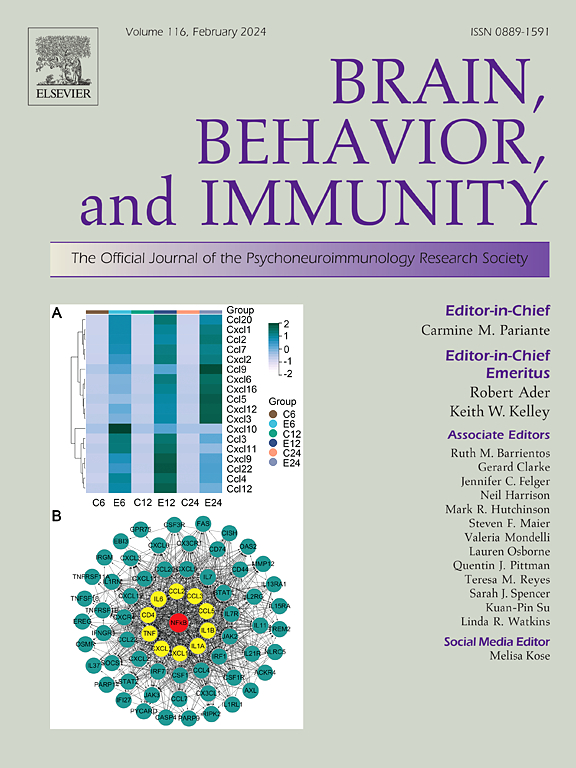Serum kynurenine metabolites and cytokine levels: diagnostic and predictive implications in acute manic episodes of bipolar disorder
IF 7.6
2区 医学
Q1 IMMUNOLOGY
引用次数: 0
Abstract
In this study, we aimed to integrate serum cytokine and kynurenine metabolite levels to identify key biomarkers for diagnosing and predicting treatment outcomes in bipolar disorder during manic episodes (BDM). A total of 52 patients with BDM and 49 healthy controls (HCs) were recruited. Serum levels of cytokines and kynurenine metabolites were measured at baseline. Manic symptom severity was assessed using the Young Mania Rating Scale (YMRS) at baseline and after 8 weeks of treatment. Correlations between cytokines and kynurenine metabolites were analysed. Support Vector Machine (SVM) classifiers and Partial Least Squares (PLS) regression were employed to differentiate individuals with BDM from HCs and to predict treatment outcomes based on these profiles. Key findings included: (1) significant differences in kynurenine metabolites between individuals with BDM and HCs, whereas cytokine levels did not differ significantly; (2) weaker correlations between cytokines and kynurenine metabolites in individuals with BDM compared to HCs; (3) integrated models of kynurenine and cytokine systems achieved 89 % cross-validated accuracy in classifying individuals with BDM and HCs, outperforming models based on either system alone; and (4) interleukin (IL)-10, IL-8, kynurenine, IL-4, and tryptophan were key predictors of treatment outcomes, with IL-10 correlating significantly with 8-week treatment response. This study highlights the potential of integrating these systems to improve diagnostic accuracy and predict treatment outcomes in individuals with BDM, offering insights into novel therapeutic targets.
血清犬尿氨酸代谢物和细胞因子水平:双相情感障碍急性躁狂发作的诊断和预测意义
在这项研究中,我们旨在整合血清细胞因子和犬尿氨酸代谢物水平,以确定诊断和预测躁郁症躁狂发作(BDM)治疗结果的关键生物标志物。总共招募了52名BDM患者和49名健康对照(hc)。在基线时测定血清细胞因子和犬尿氨酸代谢物水平。在基线和治疗8周后,使用青年躁狂症评定量表(YMRS)评估躁狂症状严重程度。分析细胞因子与犬尿氨酸代谢物的相关性。采用支持向量机(SVM)分类器和偏最小二乘(PLS)回归来区分BDM和hcc患者,并根据这些特征预测治疗结果。主要发现包括:(1)BDM和hcc患者的犬尿氨酸代谢物存在显著差异,而细胞因子水平无显著差异;(2)与hcc患者相比,BDM患者细胞因子和犬尿氨酸代谢物的相关性较弱;(3)犬尿氨酸和细胞因子系统的集成模型在BDM和hc个体分类方面达到89%的交叉验证准确率,优于单独基于任何一个系统的模型;(4)白细胞介素(IL)-10、IL-8、犬尿氨酸、IL-4和色氨酸是治疗结果的关键预测因子,其中IL-10与8周治疗反应显著相关。这项研究强调了整合这些系统的潜力,以提高BDM患者的诊断准确性和预测治疗结果,为新的治疗靶点提供了见解。
本文章由计算机程序翻译,如有差异,请以英文原文为准。
求助全文
约1分钟内获得全文
求助全文
来源期刊
CiteScore
29.60
自引率
2.00%
发文量
290
审稿时长
28 days
期刊介绍:
Established in 1987, Brain, Behavior, and Immunity proudly serves as the official journal of the Psychoneuroimmunology Research Society (PNIRS). This pioneering journal is dedicated to publishing peer-reviewed basic, experimental, and clinical studies that explore the intricate interactions among behavioral, neural, endocrine, and immune systems in both humans and animals.
As an international and interdisciplinary platform, Brain, Behavior, and Immunity focuses on original research spanning neuroscience, immunology, integrative physiology, behavioral biology, psychiatry, psychology, and clinical medicine. The journal is inclusive of research conducted at various levels, including molecular, cellular, social, and whole organism perspectives. With a commitment to efficiency, the journal facilitates online submission and review, ensuring timely publication of experimental results. Manuscripts typically undergo peer review and are returned to authors within 30 days of submission. It's worth noting that Brain, Behavior, and Immunity, published eight times a year, does not impose submission fees or page charges, fostering an open and accessible platform for scientific discourse.

 求助内容:
求助内容: 应助结果提醒方式:
应助结果提醒方式:


